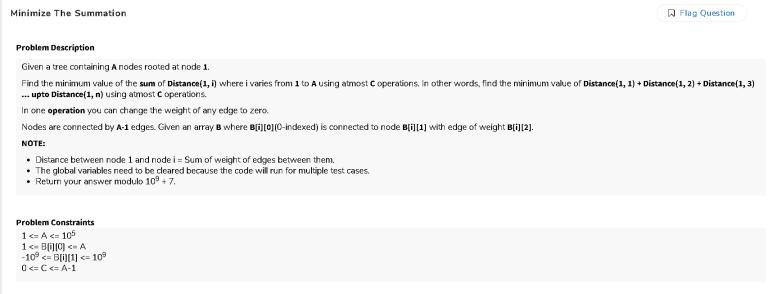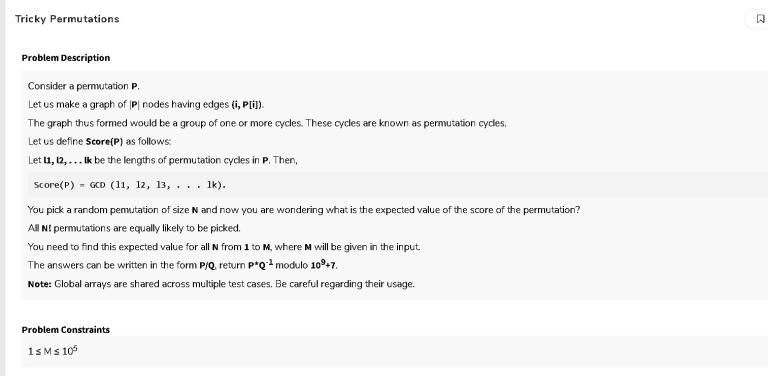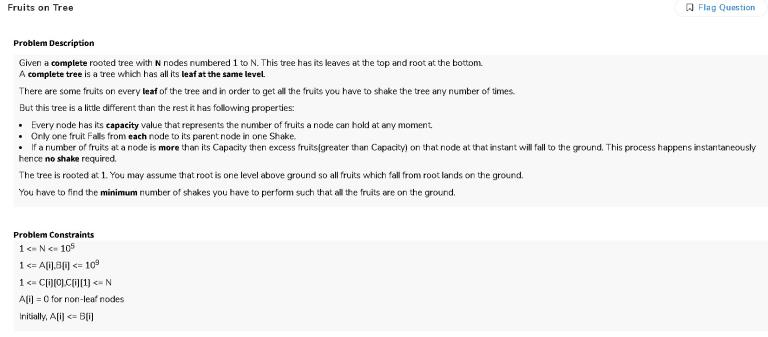Note :- The contest ended on 8 Aug
Here are the problems :-
Problem 1
Problem 2
Problem 3
Problem 4
Problem 5
It would be a great help if anyone could provide ideas about solving problem 3 and problem 5. Please share problems similar to problem 5 if anyone has seen such kind of problem before. Thanks
















this was my answer to the first question but it was giving me only partial answer can someone tell me what's wrong with this pls I just check that how many times will we traverse an edge and if the weight of that edge is negative then we will never remove it and if it's positive I add it in array to calculate later so, at last, I have the array whose weights were positive multiplied by the time they will come and removed k from them
Your logic is correct, I did the same, here's my code.
Where was this contest held ?
Link
If possible post a text version, it is hurting my eyes when I try to read it
can u also post the given test cases for problem 5.
Does anyone know how the 5th problem will be solved?
Please post solutions/editorials of 3rd and 5th question.
Tagging kal013 as he was the only one who solved third question,
I referred generating function blog written by zscoder but I could only Calculate for specific n and small n(around 1000). I could not solve for each i from 1 to n, in the 3rd question,as it's very complex maths and also not available on oeis, so it might be some sieve related calculation
Also tagging sudoBug,nagpaljatin1411 please help me here for 5th question.
My 5th Question Approach:- Since all the leaf nodes were at same level, so we needed to see for how many seconds continuously a node would drop fruits(call it
Ans of Node) [As there was no such case where it'd not drop fruits continuously]. While in a dfs, for a node, I calculated the[Sum]of fruits it recieved, and the[Max]number of fruit it recieved from all it'd children nodes. The Ans of a Node was[Max]-min([Sum]-[Max],it's capacity). You had to returnAns of Node[1] + the Depth of Leaf Nodes - 1.The Ans of a Node was
[Max]-min([Sum]-[Max],it's capacity). You had to returnAns of Node[1] + the Depth of Leaf Nodes - 1. I am unable to understand this can you pls explain.I'd explain by an example, You have a Node say i (which is not a leaf node) with it's children's Ans being
5, 8, 15respectively. Now you know, that atleast for 15 seconds, Node i would constantly drop fruits, which leaves you with 13(15+8+5-15) fruits after 15 seconds. Now if your capacity is something less than 13, say 9, then fruits would fall for 9 more seconds (the 4 would fall directly to ground), else it'd fall for 13 more seconds. It doesn't matter, when the 4 fruits fall to the ground. Note that Ans of Leaf Nodes is equal to the Number of fruits they have i.e. A[i].Now for the Actual Answer which you had to return, The 1st Fruit from Leaf Node takes 'Depth-1' time to reach the Node-1, Now if Root was leaf Node, then Ans would have been
Ans of Node-1, and if it's not, then the answer isAns of Node-1 +depth-1.thanks ,i got it
My $$$O(Nlog^2 N)$$$ solution for problem 3:
N here is the maximum limit for which all answers have to be found.
Let $$$f(n,g)$$$ be ways of choosing permutations such that each cycle length is a multiple of g. Let $$$h(n,g)$$$ be ways such that gcd of the cycle lengths = $$$g$$$.
The final answer is the $$$ \sum_{g=1}^{n} g * h(n, g) $$$ for any $$$n$$$ ( $$$h(n, g) = 0$$$ if $$$g$$$ does not divide $$$n$$$).
Now we have the following relation:
If we are able to calculate $$$f(n,g)$$$ over all pairs $$${g, n}$$$ such that $$$g | n$$$, then we can calculate $$$h(n, g)$$$ in $$$O(N log ^ 2 N)$$$, by noting that for each $$${g, n}$$$:
$$$h(n, k*g)$$$ is $$$0$$$ if $$$k*g$$$ does not divide n or $$$k$$$ is not a divisor of $$$\frac{n}{g}$$$.
So by iterating only over factors of $$$\frac{n}{g}$$$, we can see that for each $$$g$$$, number of steps taken will be
Summing this over all g, we get the desired complexity.
Now to calculate $$$f(n,g)$$$, choose size of cycle containing $$$n$$$. If the size is $$$k*g$$$ then ways =
$$$f(n, g) = \sum_{k = 1}^{\frac{n}{g}} (n - 1)! * (\frac{f(n - kg, g)} {(n - kg)!})$$$
This can be computed in $$$O(N log^2N)$$$ by using the previous trick or in $$$O(N log N)$$$ by maintaining a running sum of $$$\frac{f(n - k*g, g)}{(n - k *g)!}$$$
EnEm zeus_iitg please help us with 3rd and 5th question.
For the 3rd problem, evilbuggy described a solution that solves for a fixed $$$N$$$ (not for all $$$N$$$ from $$$1$$$ to $$$N$$$) in $$$\mathcal{O}(N \log n \cdot \mathtt{div} N)$$$.
Consider the tuple (c_1, c_2, ... c_n) (also known as cycle structure) corresponding to a given permutation where c_i denotes number of cycles of length i in the permutation.
Number of permutations which have given cycle structure (c_1, c_2, ... c_n) is equal to n!/((1^c_1 * c_1!)(2^c_2 * c_2!) .... (n^c_n * c_n!)) (Well known problem)
The generating function of this is equal to f(t_1, t_2, ... t_n) = e^{t_1 x + (t_2 x^2)/2 + (t_3 x^3)/3 + (t_4 x^4)/4 + .....) (Again a well known problem)
Number of permutations whose cycle lengths are divisible by k is equal to coefficient of x^n in f(0, 0, ... t_k, 0, 0, ...t_2k, ...) (Substitute 1 at t_k, t_2k, ....)
Then it's just mobius shit after this
I guess the time complexity is O(n log(n) tou(n)) where tou(n) is number of divisors of n
Where is the ranklist?